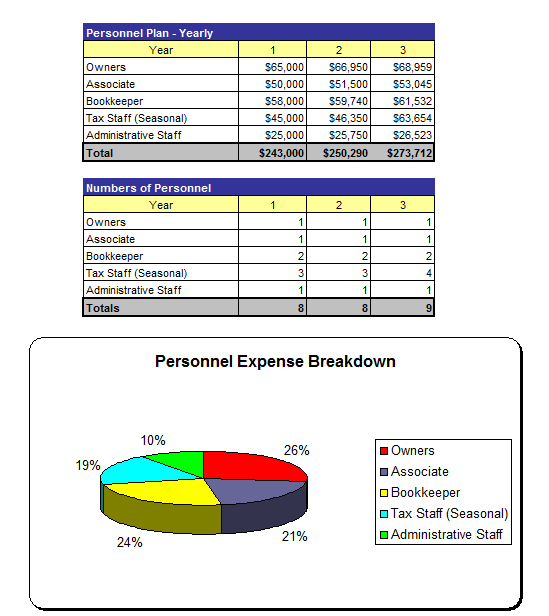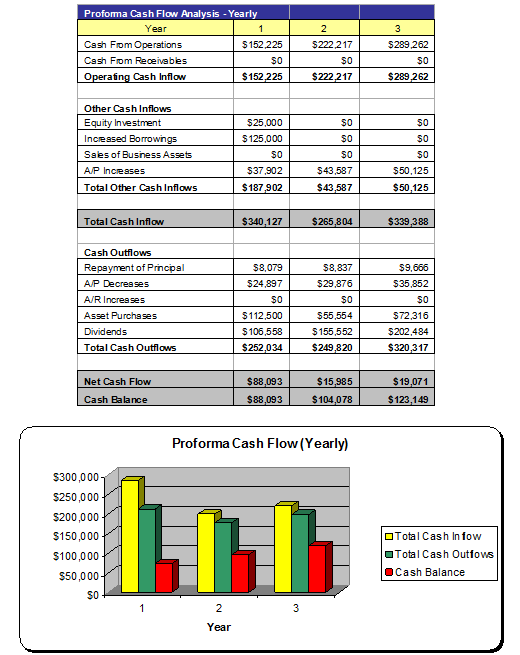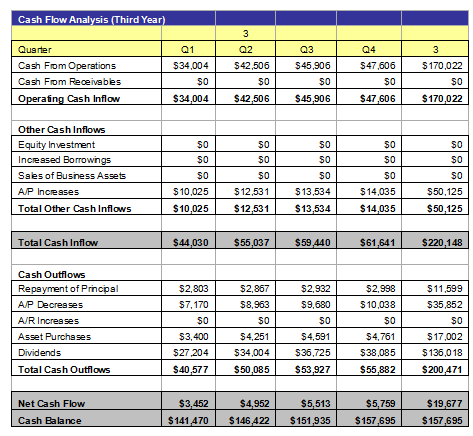Free Soybean Farm Business Plan
For Raising Capital from Investors, Banks, or Grant Companies!
Please note that the financials
in this complete free business plan are completely fictitious and may not
match the text of the business plan below. This free business plan demonstration
purposes only. If you are interested in purchasing the completed editable MS Word
and Excel documents for this business plan, please click the button below! Also,
the text of the business plan is formatted with a fully automated
table of contents.
Return to
Samples Page
It should be noted that there is no special software required to use these
templates. All business plans come in Microsoft Word and Microsoft Excel format.
Each business plan features:
- Excecutive Summary
- Company and Financing Summary
- Products and Services Overview
- Strategic Analysis with current research!
- Marketing Plan
- Personnel Plan
- 3 Year Advanced Financial Plan
- Expanded Financial Plan with Monthly Financials
- Loan Amortization and ROI Tools
- FREE PowerPoint Presentation for Banks, Investors,
or Grant Companies!
1.0 Executive Summary
The purpose of this business plan is to raise $900,000 for the development of an organic soybean farm facility while showcasing the expected financials and operations over the next three years. Soybean Farm, Inc. (“the Company”) is a New York based corporation that will provide sales of organic soybeans to customers in its targeted market. The Company was founded by John Doe.
1.1 Products and Services
As stated above, the primary revenue stream for the business will come from the sale of soybeans to the general public directly from the Soybean Farm facility and through distribution agreements with local retailers and restaurants. Secondary streams of revenue will include providing customers with the ability to tour the Soybean Farm facility and pick their own produce. The third section of the business plan will further describe the services offered by the Soybean Farm.
1.2 The Financing
Mr. Doe is seeking to raise $900,000 from as a bank loan. The interest rate and loan agreement are to be further discussed during negotiation. This business plan assumes that the business will receive a 15 year loan with an 8% fixed interest rate. The financing will be used for the following: • Development of the Company’s Soybean Farm location. • Financing for the first six months of operation. • Capital to purchase equipment needed for the Soybean Farm. Mr. Doe will contribute $100,000 to the venture.
1.3 Mission Statement
The Soybean Farm’s mission is to become the recognized leader in its targeted market for sales of freshly grown and organic soybeans.
1.4 Mangement Team
The Company was founded by John Doe. Mr. Doe has more than 10 years of experience in the farming industry. Through his expertise, he will be able to bring the operations of the business to profitability within its first year of operations.
1.5 Sales Forecasts
Mr. Doe expects a strong rate of growth at the start of operations. Below are the expected financials over the next three years.

1.6 Expansion Plan
The Founder expects that the business will aggressively expand during the first three years of operation. Mr. Doe intends to implement marketing campaigns that will effectively target farms, retailers, restaurants, and the general public within the target market.
2.0 Company and Financing Summary
2.1 Registered Name and Corporate Structure
Soybean Farm, Inc. The Company is registered as a corporation in the State of New York.
2.2 Required Funds
At this time, the Soybean Farm requires $900,000 of debt funds. Below is a breakdown of how these funds will be used:

2.3 Investor Equity
Mr. Doe is not seeking an investment from a third party at this time.
2.4 Management Equity
John Doe owns 100% of the Soybean Farm, Inc.
2.5 Exit Strategy
If the business is very successful, Mr. Doe may seek to sell the business to a third party for a significant earnings multiple. Most likely, the Company will hire a qualified business broker to sell the business on behalf of the Soybean Farm. Based on historical numbers, the business could fetch a sales premium of up to 8 times earnings (including the value of appreciated real estate).
3.0 Products and Services
Below is a description of the services offered by the Soybean Farm.
3.1 Sales of Organic Soybeans
The primary revenue stream for the business will come from the sale of organic soybeans to the general public (directly from the organic farm) as well as through local distribution channels such as restaurants, hotels, supermarkets, and small retailers. In time, Management may frequently attend farmer’s markets that will allow the business to further divest inventories.
4.0 Strategic and Market Analysis
4.1 Economic Outlook
This section of the analysis will detail the economic climate, produce industry, the customer profile, and the competition that the business will face as it progresses through its business operations. Currently, the economic market condition in the United States is sluggish. This slowdown in the economy has also greatly impacted real estate sales, which has halted to historical lows. Many economists expect that this sluggish will continue for a significant period of time, at which point the economy will begin a prolonged recovery period. This should have only a modest impact on the Company’s ability to generate revenues from its organic farming operations.
4.2 Industry Analysis
Within the United States, there are approximately 6,000 farms that specialize in the production of organic produce (including soybeans). Each year, these businesses generate almost $8 billion of revenues and provide jobs to more than 70,000 people. Annual payrolls in each of the last five years has exceeded $1 billion. This is a mature industry, and the expected future growth rate is expected to equal that of the general economy. The demand for fruit has continued to remain strong despite the current economic climate.
4.3 Customer Profile
The Soybean Farm’s average client will be a produce distributor, restaurant, hotel, or supermarket in the Company’s target market. Common traits among clients will include: • Annual revenues exceeding $1,000,000 • Operates no more than 25 miles from the Company’s location. • Will spend $5,000 to $30,000 with the Company on an annual basis.
4.4 Competitive Analysis
This is one of the sections of the business plan that you must write completely on your own. The key to writing a strong competitive analysis is that you do your research on the local competition. Find out who your competitors are by searching online directories and searching in your local Yellow Pages. If there are a number of competitors in the same industry (meaning that it is not feasible to describe each one) then showcase the number of businesses that compete with you, and why your business will provide customers with service/products that are of better quality or less expensive than your competition.
5.0 Marketing Plan
The Soybean Farm intends to maintain an extensive marketing campaign that will ensure maximum visibility for the business in its targeted market. Below is an overview of the marketing strategies and objectives of the Company.
5.1 Marketing Objectives
-
• Establish relationships with organic produce distributors, retailers, and restaurants throughout the target market.
-
• Implement a local campaign with the Company’s targeted market via the use of flyers, local newspaper advertisements, and word of mouth advertising.
-
• Develop an online presence by developing a website and placing the Company’s name and contact information with online directories.
5.2 Marketing Strategies
Mr. Doe intends on using a number of marketing strategies that will allow the Soybean Farm easily target buyers within the target market. These strategies include traditional print advertisements and ads placed on search engines on the Internet. Below is a description of how the business intends to market its services to the general public. The Soybean Farm will also use an internet based strategy. This is very important as many people seeking local services, such as organic soybean farming operations, now the Internet to conduct their preliminary searches. Mr. Doe will register the Soybean Farm with online portals so that potential customers can easily reach the business. The Company will also develop its own online website showcasing the Soybean Farm facility, its inventory of organic produce, preliminary pricing information, and contact information.
5.3 Pricing
In this section, describe the pricing of your services and products. You should provide as much information as possible about your pricing as possible in this section. However, if you have hundreds of items, condense your product list categorically. This section of the business plan should not span more than 1 page.
6.0 Organizational Plan and Personnel Summary
6.1 Corporate Organization

6.2 Organizational Budget

6.3 Management Biographies
In this section of the business plan, you should write a two to four paragraph biography
about your work experience, your education, and your skill set. For each owner or
key employee, you should provide a brief biography in this section.
7.0 Financial Plan
7.1 Underlying Assumptions
-
• The Soybean Farm will have an annual revenue growth rate of 10% per year.
-
• The Owner will acquire $900,000 of debt funds to develop the business.
-
• The loan will have a 15 year term with an 8% interest rate.
7.2 Sensitivity Analysis
During times of economic recession or a sluggish economy, the Company may have issues with top line income as ranchers scale down their buying activities and farmers cut back on capital expenditures. However, the demographics target by the Company have tremendous economic staying power, and as such, declines in general economic productivity should have only a moderate effect on the Company’s revenues.
7.3 Source of Funds

7.4 General Assumptions

7.5 Profit and Loss Statements

7.6 Cash Flow Analysis

7.7 Balance Sheet
 .
.
7.8 General Assumptions

7.9 Business Ratios

Expanded Profit and Loss Statements




Expanded Cash Flow Analysis



